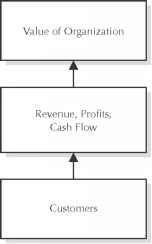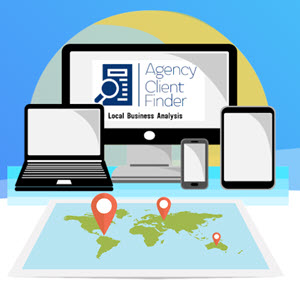Increasing Your Customer Satisfaction
What is the one thing you need to have a business? Is it a product? A factory? A service? A license? Inventory? A location? Employees? The one thing you need to have a business is a customer. A customer is someone who thinks your product or service is worth paying for and who purchases it. Without customers, there is no revenue, no profits, and no cash flow, and therefore no business. Satisfying your customers should be at the heart of your marketing efforts—although keep in mind you need to do so at a profit. This chapter shows you how to increase your customers' satisfaction.
Hierarchy of Objectives
The objectives of an organization (Exhibit 15.1) form a hierarchy, and getting and keeping customers is the most fundamental objective. Customers provide revenue, profits, and cash flow that translate into value of the business. One of the founders of GE supposedly said to his salespeople, "I don 't care if you burn down the factory, don 't be rude to a customer." The point, of course, was that you can always rebuild a factory; you may never regain a customer who is lost.
Customer Satisfaction: Trump International Hotel & Tower, New York City
This story, related by a former general manager of the New York City Trump International Hotel & Tower, shows the power—and responsibility—of having highly regarded and appreciated customer service.
Our concierge received a call late one night from a guest who was distraught over having lost a shopping bag containing something very dear to him . . . so dear, that he could not travel without it. He had checked into the hotel moments before, and remembered having the bag last at the airport. The concierge alerted me and I called the airport Lost and Found Department. They knew nothing, and could find nothing. I was not going to take no for an answer because my guest was truly upset over losing this bag and I felt that something more could be done. I headed to the airport myself, to the same terminal and baggage claim area where the guest had been a short while before. I asked the Lost and Found Department manager for help and again, they had nothing to offer. I started looking around and there, lying by a garbage can, was an old plastic bag that matched the description the guest had given me. Inside was the item that held great sentimental value—an old teddy bear! I brought it back to the hotel and returned it to the guest who was so appreciative, tears were running down his face.
To provide great service, you need a culture that values great service—and that starts at the top of your organization. If you value and expect and reward great service, your people will give it.

Trump International Lobby, at Trump International Hotel & Tower, New York City.
Photo courtesy of The Trump Organization.
Trump International Lobby, at Trump International Hotel & Tower, New York City.
Photo courtesy of The Trump Organization.
TRUMP UNIVERSITY MARKETING 101 Exhibit 15.1 Hierarchy of Objectives

Source: "Arrow Guide—The Marketing Challenge," The Arrow Group, Ltd., New York, NY, 2008. Used here with permission.
Customer-Driven Organizations
Organizations that understand the key role of customers in their success are known as customer-driven organizations.
In a customer-driven organization, decisions are made based on the knowledge of customer needs and expectations, and on the impact of those decisions on the organization-customer relationship.
Customer Satisfaction and Financial Performance
Many management gurus advocate that you should always satisfy customers— or always delight them. That is a noble sentiment, but the gurus haven 't gotten it quite right.
You should always strive to satisfy or delight customers—but at a profit. The easiest way for you to satisfy customers is to give them everything they want—at a discount—then provide liberal credit. If you do that, you will likely not stay in business—and therefore in the long run, you will not satisfy your customers because you will not be around anymore.
You Should Always Strive to Satisfy or Delight Customers— But at a Profit
If you never say no to a customer, as discussed in Chapter 3, then you do not have a strategy—no clear target market and no clear positioning. It is also true that if you never say no to a customer, then you may go out of business.
Your decisions regarding what you give to your customers always involve a trade-off between the added perceived value you provide the customer and the added costs you assume. If the additional perceived value you are providing is less than the added cost, then the organization is actually reducing its contribution to society, should go out of business, and eventually will.
Yes, being customer-driven is delighting customers—but do so at a profit.
How to Increase Customer Satisfaction
Customer-driven organizations can manage customer satisfaction by following my COPS model: Culture; Organization; Process; Strategy. Culture consists of the fundamental values of your organization. Organization refers to how your organization is structured to support customer-satisfying efforts. Process is the way you deal with customers. Strategy concerns the way you make decisions that have an impact on your customers.
Culture
Make customer satisfaction everyone 's responsibility. If your organization is customer driven, then everyone in your organization is committed to satisfying customers (at a profit). That includes the CEO. When Lou Gerstner took the top job at IBM, he made it clear that he would be the sales representative for five customers and sent a very clear message to all those in the organization regarding the importance of customers to IBM. For many years, ARAMARK has had what they called the 20/20 rule—that every manager at every level of the company had to know the top 20 customers in their area and the top 20 potential customers in their area. Top executives in some banks and airlines are required each year to spend time in positions that bring them into contact with customers.
If your highest-level managers show that they consider customers to be important, then your organization is likely to be customer driven. However, if your highest-level managers do not show attention to customers, then your organization is likely not to be customer driven.
Once when I was the first person getting on an aircraft, I heard one of the attendants exclaim, "Here come the animals." For that attendant, passengers were a nuisance, and it is very likely that that attitude carried over into how the attendant dealt with passengers during the flight. Members of an organization must show respect for customers—not thinly disguised contempt. One study showed that nearly 70 percent of customers quit being customers because of the attitudes of those employees serving customers.
Sanity Music, a chain in Australia, doubled their market share in just two years and earned more than $1.50 more per CD than their competitors partly because of the enthusiasm of their staff. Ticket takers at the Disney theme parks receive hours of instruction about treating park visitors—guests—before they begin work. What type of training do you give your customer servers?
Members of customer-driven organizations need to have what Tom Peters has called a "passion for perfection." Passion for perfection is a concern to get things right and get them right the first time. A dry cleaner who will not return clothing with stains or missing buttons, or an accountant who reminds the client when to submit his or her tax forms can have a passion for perfection. Buck Rogers, former head of sales at IBM, believed that in customer-driven organizations, employees dealing with customers must have "thoughtfulness, courtesy, and integrity." In short, they must treat customers the same way that they would like to be treated.
Organization
Make it easy to satisfy customers. If you are the person who deals with customers face-to-face or even on the telephone or Internet, you have a difficult job. When customers have something to say to you, it often will concern a problem, and if you are not able to help, the situation may become even more unpleasant. That is why customer-oriented organizations empower their employees to solve their customer 's problems.
British Air has gone to enormous lengths to provide their customer servers with power to solve customers' problems such as lost baggage or mishandled reservations. They can provide customers with gifts, upgrades, and other favors to help preserve their relationship. United Airlines allows flight attendants to recommend that passengers receive flight certificates or frequent flyer miles in reparation for problems encountered during flights such as videos or headphones that do not work.
Empowerment also raises employee morale. Employee morale, in turn, affects customers. Marriott has found that a 10 percent reduction in employee turnover reduced customer defections by 1 to 3 percent and raised revenues by millions of dollars.
Customers need to be able to communicate with customer servers, but some organizations make that communication very difficult. One oxymoronic phrase in customer service is what some organizations have on their automated customer response systems: "Your call is very important to us." That statement is usually followed with: "All customer servers are busy working with other customers." The question is: If the call is so important to them, why don't they have more customer servers working?
Dealing with customers requires skills, and that means customer servers need Craining. USAA, a large insurance company highly regarded for their customer service, often leads their industry in the percentage of their budget spent on training.
Certainly the customer servers must understand the organization 's products, services, and policies, but there are many other dimensions to dealing with customers—the human dimensions. In particular, customer servers must know how to listen and how to empathize with customers with problems. Customer servers need be trained in how to manage upset people. In some organizations, the newest and least experienced employees answer the complaint line. The employees on the complaint line should be highly trained and experienced in dealing with difficult situations.
Customer-driven organizations reward employees who satisfy customers. The rewards may be recognition such as "Employee of the Month" or bonuses. (Note: Employee of the Month parking spaces may be counterproductive, however, if they displace customer parking places.) Nordstrom's has established a Hall of Fame for acts of great customer service.
For rewards to be effective, you must publicize them. Customer-oriented organizations spotlight those who perform well with customers. They also disseminate information as to how well the organization is serving customers by publishing information on customer ratings and other measures of customer performance.
Process
Establish systems to support customer satisfaction. To manage customer satisfaction, you need to stay close to customers. You may have heard the old story of the organization that did away with its complaint line because too many customers were complaining! Customer-driven organizations talk to their customers and listen to them. Communication may be informal. If you are running a health club, it is easy and natural to talk to your customers and ask them how they like (or don't like) the club. Or focus groups or surveys may be used. Xerox is known for regularly surveying its customers. The main point is that the communication takes place on a regular basis.
When your customers complain, they are telling you that the relationship can still be saved. Most unhappy customers do not complain—they simply take their business elsewhere. When you do not hear from your customers and then do not see them, you know you are in trouble.
Processes need to be designed from the customers' viewpoint, not from the viewpoint of the organization. Many years ago, the only way to buy a ticket to a Broadway show in New York City was to go to the theater and purchase the tickets with cash. That process had a lot of advantages to the theater but was relatively difficult for the theatergoer—and consequently probably discouraged some potential customers from ever going to the theater. For many years, retail banks in the United States closed at 3 p.m.—what were known as "bankers' hours." Again, the process had been designed to make things easier for the banks, but that made it more difficult for the customers.
Organizations should look for best practices and benchmark on the best performers for whatever they do, including managing the relationships with their customers. Many organizations have been cited for high performance on customer satisfaction—Southwest Airlines and USAA insurance, for example. Managers should identify those organizations that best satisfy customers and try to learn from them.
Communications with customers must be in both directions. Hearing their opinions is very important, but it is also important to talk to them and let them know what is happening. Airlines have often done a poor job of explaining situations to passengers when flights are delayed. One of the jokes shared among passengers of the New York City subway system is the public address system—when there is a problem on the line, the sound quality of the communications equipment is so bad it is usually impossible to understand what the problem is and when it will be fixed.
There are many ways to communicate with customers—in person, of course, but also through newsletters and e-mails.
Strategy
Focus efforts on customer satisfaction. Jan Carlzon 's book, Moments of Truth, clearly set forth the idea that, if customer satisfaction is not the focus of an organization, then the organization may fail.1 The "moments of truth" to which he referred were all the points of contact that his airline, SAS, had with customers—when reservations were made, when customers checked in, when they retrieved their baggage. He pointed out that if SAS did not win these moments of truth, then their planes would be empty. (For more examples, see Schmitt.2)
A marketing strategy must have the customer at the center to be successful. The two strategic components of a marketing plan are the target market and the positioning. These two decisions are closely interlinked. Selecting a target market identifies customers and their needs. Customer needs then determine the positioning (key benefits) required to satisfy them. In customer-oriented organizations, the target market and positioning decisions are made with care and thoughtfulness, not by expediency. Wendy's has a customer focus in their marketing strategy. They were first among U.S. fast-food chains to launch entrée salads, and among the first to have extended hours and improved nutritional information—all part of their customer-centered strategy.3
A marketing strategy must have the customer at the center to be successful.
Over time, all organizations need new customers. However, for many organizations, the real problem is retaining current customers. Revenue, profitability, and cash flow are all extraordinarily sensitive to customer retention rates. Customer-oriented organizations understand this and focus on doing things to retain customers. At Master Care Auto Service, employees who kept customers loyal received a bonus that could be as much as 10 percent of their salary.
In the Rocks section of Sydney, Australia, is a restaurant called Wolfie 's Grill that I have gone to over many years. The view of the Harbour Bridge is spectacular, but that's not why I continue to go there. I go for the service. The first time I went there one of our sons was only a year old and rather finicky. Wolfie 's chef produced a meal our boy would eat and the waitstaff didn't seem to mind the clean-up afterward. Since then I have returned often and always found their service delightful—even over many changes in managers. What is that consistency worth? A lot.
A focus on retaining customers brings in new customers as well. The habits you need to keep your customers are exactly the habits that you need to attract new customers. Plus, positive word-of-mouth from your current customers is probably more effective than any advertising you could devise to persuade new customers to try your product or service. I have recommended Wolfie 's to many friends and relatives when they visit Australia.
Customer satisfaction is linked to revenue, profits, and cash flow through perceived value. Therefore, it is a leading indicator for the financial performance of an organization and must be monitored. The monitoring can be done directly with surveys or indirectly with operations measures (for example, process times, number of complaints), but monitoring must be done to provide the organization with steering control. When Swissair surveyed their passengers, they expected good or excellent ratings to be close to 100 percent. (See Chapter 36 for more on how to survey your customers.)
Conclusions
Customers are the source of all your financial returns—your revenue, profits, and cash flow. Therefore, they are also the source of shareholder value. Satisfying customers—at a profit—should be a major objective of any organization if it is to have success over time.
For review questions for this chapter and for a test as to how well your organization satisfies customers, log on to www.trumpuniversity.com/ marketing101.
Continue reading here: Sales Objectives
Was this article helpful?
